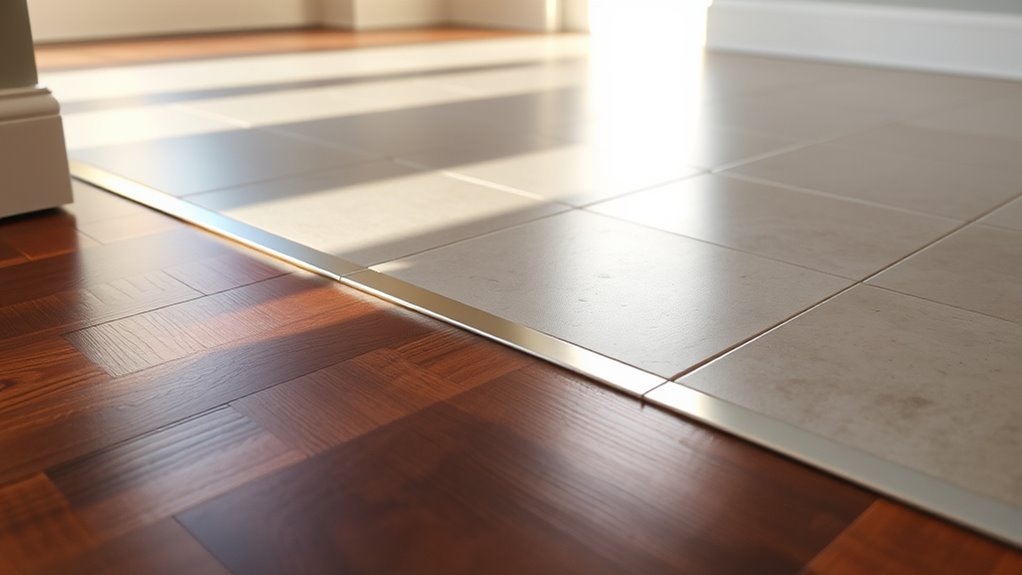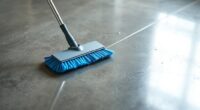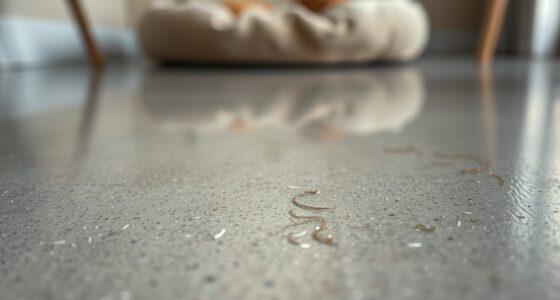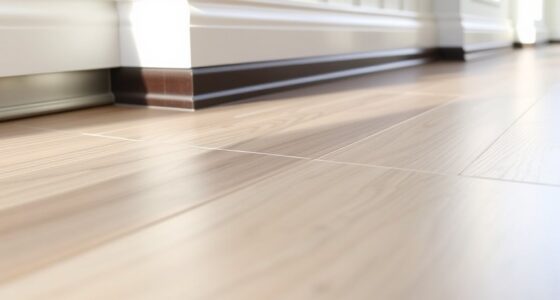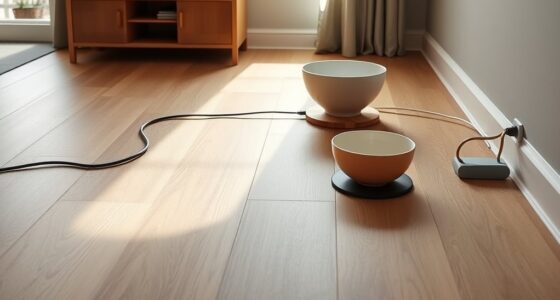Installing thresholds on sealed hardwood floors can be tricky because the sealant reduces adhesion, making it hard for thresholds to stay in place. To succeed, choose thresholds like reducers, T-molding, or saddle types that suit your setup and opt for durable, low-profile materials like aluminum or hardwood with anti-slip features. Proper measurement, secure fastening, and careful surface prep are key. Want to know the best techniques for a long-lasting, professional finish? Keep exploring to find out more.
Key Takeaways
- Choose thresholds made from durable materials like aluminum or hardwood with low-profile or beveled edges for smooth crossing.
- Use proper surface preparation, ensuring the sealed floor is clean and dry before installation to improve adhesion and stability.
- Opt for thresholds specifically designed for sealed floors, such as reducer or T-molding, to accommodate height differences and movement.
- Secure thresholds with appropriate fasteners and adhesive while ensuring they are level to prevent tripping or shifting.
- Regularly inspect and tighten fasteners, and clean thresholds to maintain a safe, functional transition on sealed hardwood surfaces.
Understanding the Challenges of Thresholds on Sealed Hardwood Floors
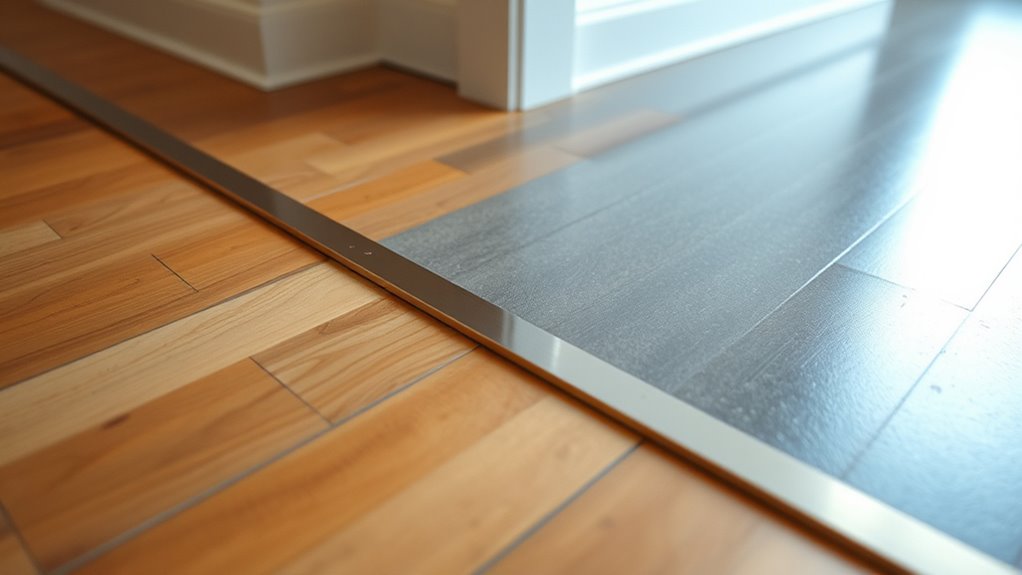
Sealed hardwood floors can present unique challenges when installing thresholds, primarily because the sealant creates a smooth, impermeable surface. This smoothness makes it difficult for adhesives to grip properly, risking loose or unstable thresholds. The sealant’s impermeability also prevents good contact between the threshold and the floor, increasing the chances of gaps or shifting over time. You might find that nails or screws don’t hold as well, since the sealant can prevent proper penetration. Additionally, applying sealant after installation can cause it to seep into the threshold interface, making future adjustments messy or impossible. To overcome these challenges, you need to prepare the surface carefully and choose installation methods compatible with a sealed floor, ensuring your threshold stays secure and functional. Using appropriate fastening techniques can help improve the stability and longevity of thresholds on sealed hardwood.
Types of Effective Thresholds for Hardwood Transitions
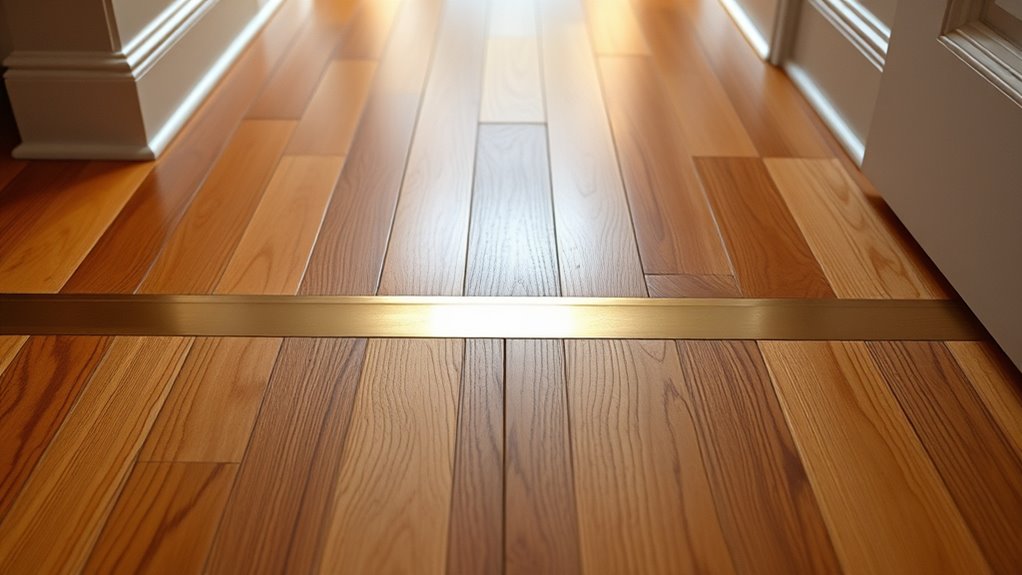
Choosing the right threshold type can make a significant difference in guaranteeing a secure and durable connection between hardwood floors. Transition strips like reducer thresholds work well when floors are at different heights, allowing a smooth slope. T-molding thresholds are ideal for connecting two floors at the same height, providing a seamless look. Saddle thresholds are effective for covering gaps or uneven areas, offering flexibility. U-shaped thresholds provide a secure fit for doorways and entry points, preventing movement. Overlap thresholds are useful for transitions where one floor overlays another, offering extra stability. Each type serves a specific purpose, so selecting the appropriate one depends on your floor heights, layout, and usage. Proper choice guarantees safety, aesthetic appeal, and long-lasting performance. Additionally, understanding relationship dynamics can help ensure that your transition choices align with your household’s needs and maintain a harmonious environment.
Materials and Features to Look for in Crossings

When selecting crossing thresholds for your hardwood floors, paying attention to the materials and features can guarantee a long-lasting, secure transition. Look for thresholds made from durable materials like aluminum, brass, or hardwood itself, which resist wear and moisture. These materials should complement your flooring’s finish and color for a seamless look. Features like a low profile or beveled edges help prevent tripping hazards and make crossing smoother. An anti-slip surface adds safety, especially in high-traffic areas. Check for adjustable height options that match your flooring levels precisely. Additionally, choose thresholds with strong installation options, such as screw or adhesive mounts, to ensure stability over time. Quality materials and thoughtful features create a crossing that’s both functional and visually appealing. Be mindful of trust issues that might affect your comfort when making home improvements, ensuring your choices foster a secure and confident environment.
Step-by-Step Guide to Installing Hardwood-Friendly Thresholds

Installing hardwood-friendly thresholds involves careful preparation and precise measurement to guarantee a perfect fit. First, measure the width of the gap between your rooms accurately, accounting for any expansion space needed. Mark the threshold length on the material, then use a saw to cut it to size. Next, position the threshold in the doorway to ensure it fits snugly. If you’re using adhesive, apply it evenly along the bottom of the threshold and press it firmly into place. Alternatively, if you’re using screws or nails, pre-drill holes to prevent splitting, then secure the threshold. Make sure it’s level and flush with the floor surface. To ensure a long-lasting installation, choose appropriate hardware that won’t damage your hardwood. Finally, clean any excess adhesive or debris, and double-check that the threshold doesn’t interfere with door movement.
Tips for Maintaining and Adjusting Floor Transitions
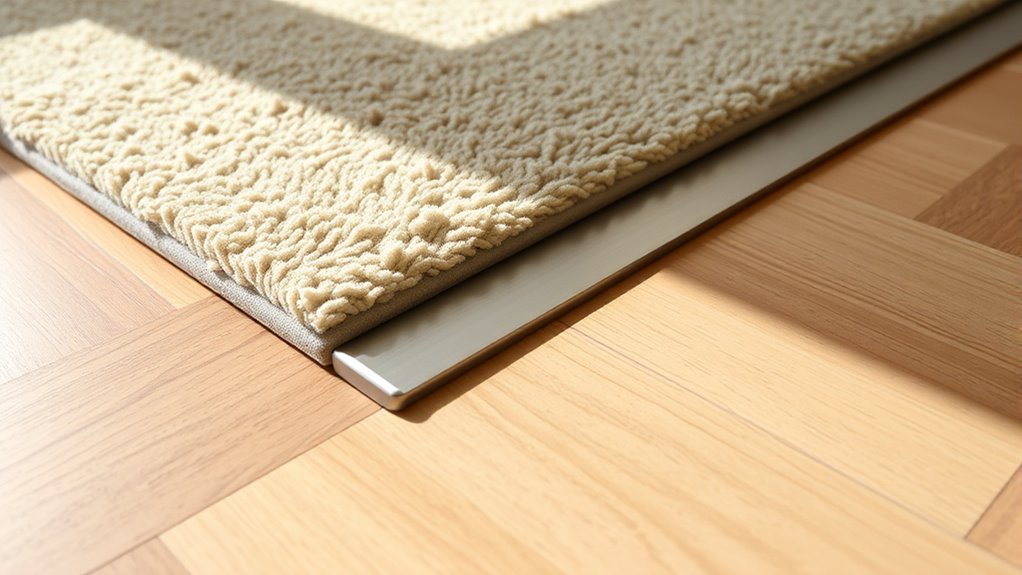
Maintaining and adjusting floor crossings is essential for ensuring smooth movement and preventing damage over time. Regularly inspect your thresholds for loose screws, gaps, or warping. Tighten any loose fasteners to keep the transition secure. If you notice gaps or unevenness, consider re-adjusting or replacing the threshold to maintain a flush surface. Clean the transition strip with a gentle cleaner to remove dirt and debris that can cause sticking or wear. For adjustable thresholds, loosen the screws, reposition the strip, and tighten securely to fit the flooring height. Avoid forcing or overly tightening, as this can damage the hardwood or threshold. Routine care and timely adjustments help your floor transitions stay functional, safe, and visually appealing for years. When planning outdoor kitchen features, consider durable thresholds that can withstand exposure to weather and frequent use.
Frequently Asked Questions
Are There Specific Thresholds Recommended for High-Traffic Areas?
Yes, for high-traffic areas, you should choose thresholds that are durable and low-profile to prevent tripping. Look for thresholds made of sturdy materials like aluminum or hardwood with a smooth finish. A height of around 1/2 inch or less is ideal to guarantee safety and ease of movement. Make certain the threshold fits snugly without gaps, providing a seamless passage that can withstand constant use.
How Do Thresholds Affect Hardwood Floor Warranties?
Think of thresholds as guardians for your hardwood floor, protecting your warranty like a shield. If you install the right type of threshold and follow proper sealing procedures, your warranty stays intact. However, improper thresholds can cause gaps, moisture intrusion, or damage, jeopardizing coverage. Always choose thresholds compatible with hardwood floors and guarantee professional installation to keep your warranty safe and your floors beautiful.
Can Thresholds Be Customized to Match Floor Colors or Styles?
Yes, thresholds can be tailored to match your floor’s colors or styles. You can choose from a variety of materials, finishes, and designs to blend seamlessly or create a contrasting accent. Many manufacturers offer custom options, so you can select a stain, wood type, or metal finish that complements your hardwood. Discuss your preferences with your installer to ensure the threshold enhances your space and matches your aesthetic perfectly.
What Safety Considerations Are Essential for Threshold Installation?
You should prioritize slip resistance when installing thresholds, especially if you have households with children or elderly. For example, a homeowner in a rainy climate installed textured thresholds, which notably reduced slips. Make certain the threshold is securely anchored to prevent tripping hazards and choose materials compatible with your flooring to avoid gaps. Regularly inspect and clean the threshold to maintain safety, especially in high-traffic areas.
Are There Eco-Friendly Options for Durable Hardwood Thresholds?
Yes, you can choose eco-friendly durable hardwood thresholds made from sustainably sourced or reclaimed materials. Look for options labeled FSC-certified or made from bamboo, cork, or reclaimed wood, as these are environmentally responsible choices that don’t compromise on durability. By selecting these materials, you support sustainable forestry practices and reduce environmental impact while ensuring your threshold remains sturdy and long-lasting.
Conclusion
By choosing the right thresholds, you’re crafting a smooth path where your hardwood floors meet seamlessly. Think of these crossings as the bridges that keep your home flowing effortlessly, preventing trips and tears. With careful selection, proper installation, and regular maintenance, your passages will stand strong like a well-built bridge. So, take control of your space and turn these crossings into your home’s quiet heroes—making every step feel natural and safe.
